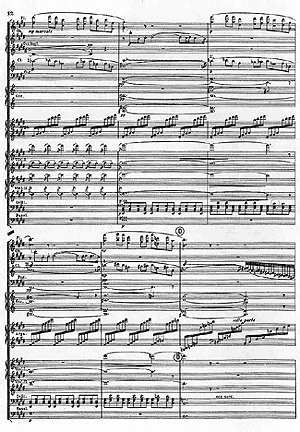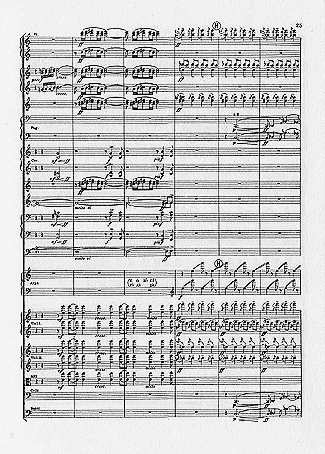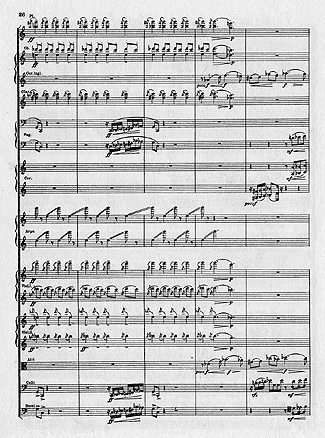Op. 49 Pohjola's Daughter (Pohjola's Daughter), symphonic fantasy. Completed in 1906; first public performance in St Petersburg, 29th December 1906 (Orchestra of the Marinsky Theatre under Jean Sibelius).
Pohjola's Daughter is one of Sibelius's most popular symphonic poems. It was not until the late 1990s that scholars were able to work out the complicated stages of its composition.
The difficulties were caused by several intertwining ideas and projects that were going on at the same time. One of these comprised the "Daughter of Nature" material. Another project was the third symphony, and a third was Night Ride and Sunrise. A fourth project consisted of the sketches to In memoriam and a fifth the oratorio .
Marjatta, which Sibelius was planning on the basis of Jalmari Finne's libretto, starting from June 1905. Finne wrote enthusiastically about this project:
"Sibelius talked about music in such a beautiful way. He also said: 'Music is for me like a beautiful mosaic which God has put together. He takes all the pieces in his hand, throws them into the world, and we have to recreate the picture from the pieces.'"
The mosaic metaphor is apt. Without knowing it, Sibelius was unknowingly already composing Pohjola's Daughter, but initially he called the earliest form of the work "Luonnotar" (Daughter of Nature). This is not the Luonnotar we know from 1913, which is why it is customary to write about the earlier project using quotes. It is not surprising that the Marjatta and Luonnotar ideas were equally fascinating to Sibelius. The female figures are mythologically very close to each other. Marjatta gives birth to the Saviour, Luonnotar to the world.
The libretto of the oratorio and the letter in which Jalmari Finne clarified the structure of the oratorio were found in the 1990s as a result of research by Markku Hartikainen. Finne wrote as follows:
"The text is in three parts, 'The birth of Jesus', 'The burial of Jesus' and 'The resurrection'. The Finnish people have come upon a musical idea that could not be bettered. I mean the 'resurrection'. At the request of Marjatta the sun flies to the grave Jesus in the form of a big bird, and as it shines with increasing power it melts the mountains and rocks and releases Jesus from death. I knew what a ball of fire I threw into Sibelius's soul when I gave him the idea. He told me himself that there could not be a more magnificent connection than that between Jesus and the sun and that such an oratorio would be something entirely new."
On 20th August 1905 Sibelius wrote to Carpelan that he was composing
"a work in a "quasi oratorio style" - i.e. Marjatta. However, at the end of August the plan changed. Sibelius was invited to Heidelberg to conduct his works there in November, and he decided to prepare "Daughter of Nature" for the occasion. Finne's text was brushed aside, but he did not abandon the Marjatta music.
Among Sibelius's drafts there is a section which corresponds to the start of Pohjola's Daughter. There the word "Marjatta" and slightly later the word "all" have been written above the notes (both these words appear in the first phrases of Finne's Marjatta text). It appears that the start of Marjatta was eventually transferred to the start of Pohjola's Daughter - or else Sibelius was merely seeing whether the words from Marjatta would fit a musical idea that was already in existence.
Be that as it may, in Sibelius's creative imagination "Luonnotar" was now taking the shape of a pure orchestral work rather than an oratorio. The work was not completed in time for the Heidelberg Music Festival. Sibelius decided to continue his trip with concerts in Britain in December 1905. Also, he wanted to prepare the work in his own time. From Britain the journey continued to Paris, in a trip which involved both composition and heavy drinking.
On returning home Sibelius continued to work on what would be his third symphony, but now his plans were starting to crystallise: part of the material he had sketched out would find its place in a future symphony, but first a "symphonic poem" would be prepared. And indeed, it was completed before midsummer 1906.
The composition still did not have a name, as Sibelius's imagination had already moved away from the "Luonnotar" concept. Sibelius sent to his publisher an explanation in German of the programme of the composition. This referred to Pohjola's Daughter, with no mention of "Luonnotar". The scholar Timo Virtanen has studied the drafts and shown that during the last weeks of composition Sibelius made changes to the work, apparently in order to adapt it to the Kalevala story of Väinämöinen and Pohjola's Daughter.
According to the Kaleva story, Väinämöinen, while he is journeying, hears the Maiden of Pohjola, i.e. Pohjola's Daughter, spinning golden thread on her spinning wheel in the sky. Väinämöinen asks the daughter to descend from the skies to him, but the maiden requires him to perform heroic deeds first. Väinämöinen fails to accomplish the impossible tasks and has to withdraw - a loser, but not defeated.
There is a clear connection between this intrigue and the second libretto draft of the opera The Building of the Boat, written a decade earlier. In that work, Väinämöinen falls in love with the Daughter of Nature and performs miracles, i.e. a visit to Tuonela and the building of a magic boat, but finally becomes disappointed with the coldness of the Daughter of Nature and goes off alone.
The composer suggested to the publisher that the work should be called Väinämöinen, but Lienau considered that a difficult title, suggesting instead Pohjola's Daughter. Sibelius responded by suggesting L'aventure d'un héros (The Adventure of a Hero), but that was too similar to Strauss's Heldenleben. They agreed to call the work Pohjola's Daughter.
Sibelius conducted the first public performance at a concert of the Orchestra of the Marinsky Theatre, at the invitation of the conductor Alexander Siloti. The orchestra loved the work, and the performance was a great success. Even the critics were enthusiastic. "An extremely talented and imaginative composer," wrote the magazine Rusj.
Pohjola's Daughter is orchestrated with extraordinary skill, even compared with the virtuoso orchestrating technique of Richard Strauss. It is astonishing how the composer eventually managed to build up an independent whole from drafts made for a number of different composition projects.
In the drafts for Pohjola's Daughter there are also parts which did not fit into this whole. These later ended up in the third symphony and the suite Scènes historiques II. So there truly had been material for a work of symphonic proportions, but this time the pieces of the mosaic were better suited to separate compositions.
The work begins with a low, recitative motif on the cellos. It was on the draft of this motif that Sibelius had at one time written the words "Marjatta" and "all" after trying to see whether the motif would fit the first phrases of the oratorio Marjatta.
By developing this material Sibelius presents a kind of "musical bank" into which the central elements of the orchestral poem return. According to Erkki Salmenhaara, throughout the symphonic poem the low register depicts how Väinämöinen vainly tries to reach up towards the sky.
This is followed by a bold change of key. Pohjola's Daughter is weaving in the sky. The oboe, the cor anglais and finally the flute describe the beauty of the daughter.

Excerpt from the score of Pohjola's Daughter.
Robert Lienau Musikverlag.
The following sequence may describe Väinämöinen's shock and delight on seeing the beauty of the maiden. Now the kinetic energy of the music is dissipated. The anticipatory pizzicato progressions in the strings start a development in which Väinämöinen's efforts and the daughter's sweetness and mockery are given their musical counterparts. The mocking second motif is at its wildest towards the end of the development, when it is played by the strings and woodwind.

Excerpt from the score of Pohjola's Daughter.
Robert Lienau Musikverlag.

Excerpt from the score of Pohjola's Daughter.
Robert Lienau Musikverlag.
In the development - and in the relations between the keys in the work as a whole - there are many features that look forward to the fourth symphony. In Pohjola's Daughter these materials are in a form that is more easily digestible by the general public, as the central themes are catchy and brilliantly orchestrated.
After a struggle the vision of the daughter disappears. The G-A-B progression in the double basses and the cellos tells us that Väinämöinen - and the composer - have pensively returned to the initial situation. But after such a wonderful adventure and such a blaze of colours!

